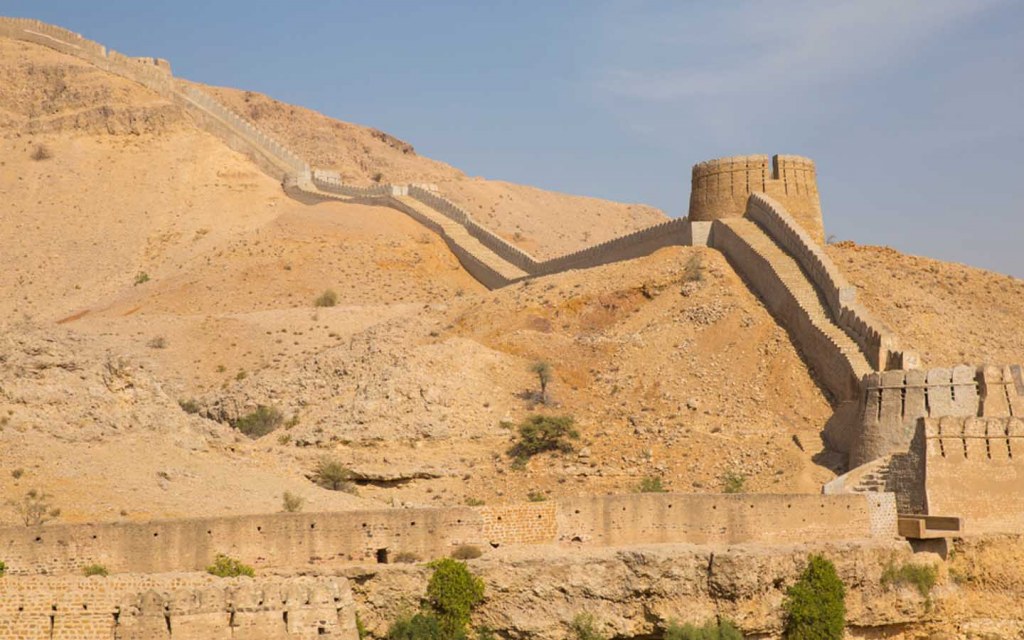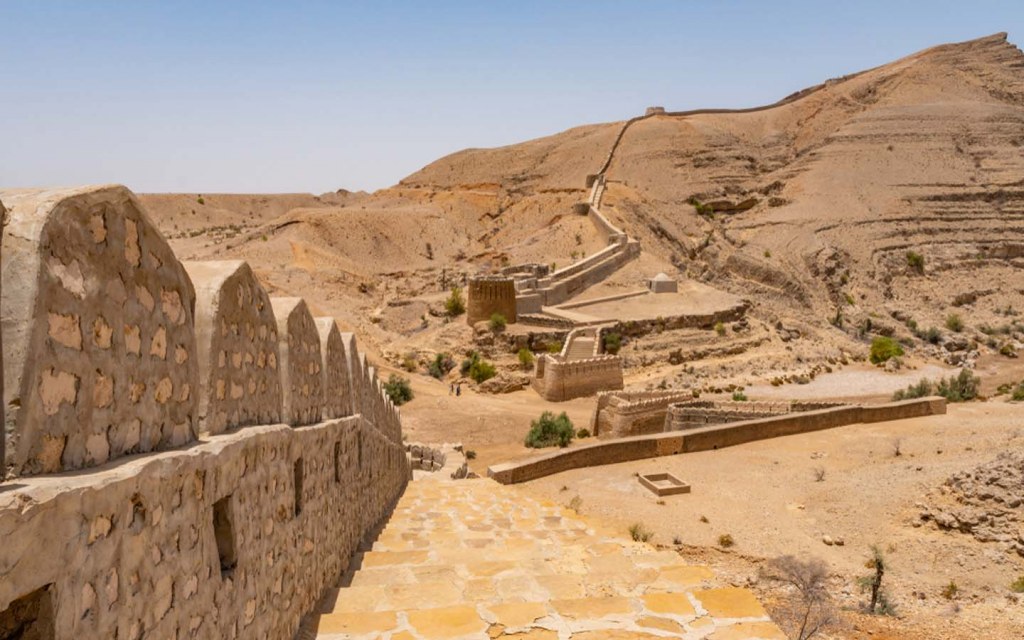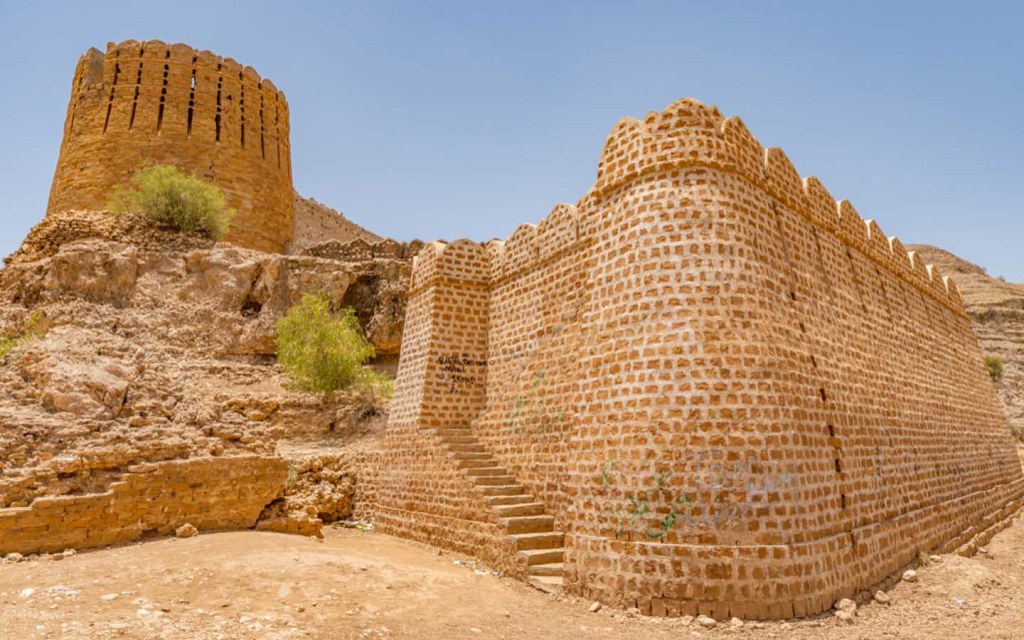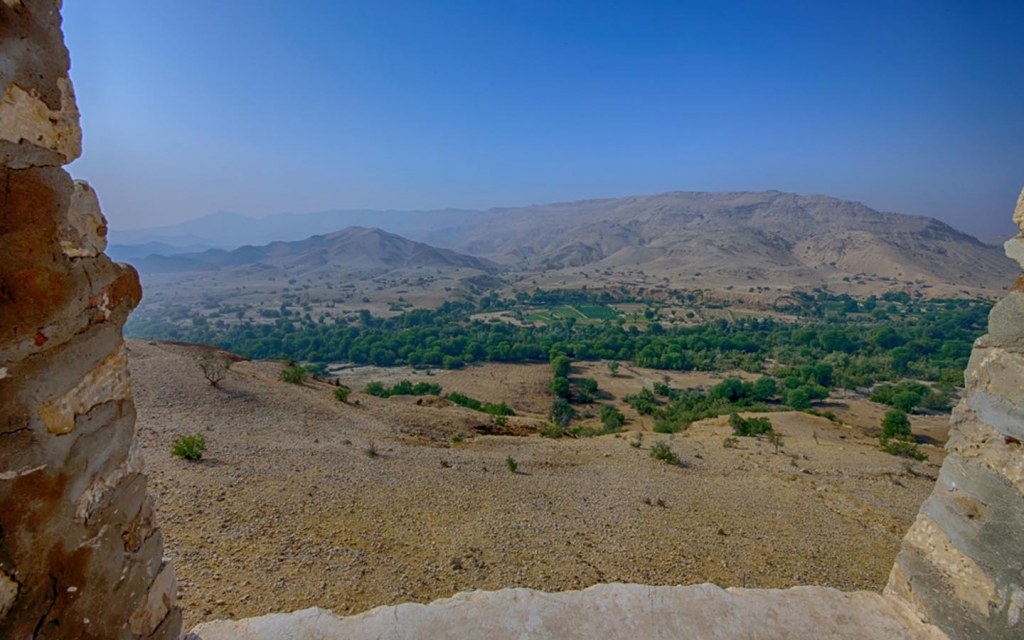In This Post
– Location of Ranikot Fort
– History of Ranikot Fort
– Features of Ranikot Fort
– The Present
At first glance, the sprawling Ranikot Fort near Jamshoro in Sindh may look like a dilapidated structure atop a hilly area with crumbling stone walls extending as far as you can see. However, this grand fort is much more than just another historical military stronghold in a region that has seen multiple invasions and battles before it finally became a part of the sovereign state of Pakistan.
Ranikot Fort has somewhat of a mysterious history, which means no one is really certain why it was built in the first place. Of course, there are several local legends associated with this historical place in Sindh that is quickly becoming one of the most popular tourist attractions in Pakistan, but the secretive origin story, awe-inspiring structure and serene location of this enigmatic fort have certainly added to its charm.
The fort is also known as the Great Wall of Sindh, owing to its resemblance to the Great Wall of China. However, unlike its well-maintained and extremely popular Chinese counterpart, Ranikot Fort has only now begun drawing the attention of tourists, historians and adventure-seekers in Pakistan. Moreover, given its entire circumference of about 32 kilometres, Ranikot is considered the largest fort in Pakistan. In fact, it is one of the largest forts in the world and has been on the tentative list of UNESCO World Heritage Sites since the 90s. Therefore, some also refer to this fort as the Great Wall of Pakistan.
Ranikot Fort, one of the biggest tourist attractions in Sindh, is protected as a historical site under the Antiquities Act, 1975.
Here are some details about the enigmatic Ranikot Fort in Sindh.
Location of Ranikot Fort

The breathtaking Ranikot Fort is located near the city of San in Jamshoro District, Sindh.
If you are visiting this historical site from Karachi, you’ll have to drive through the well-paved Karachi-Hyderabad Motorway, more commonly referred to as M-9. It’ll take you about 1.5 hours, give or take, to cross Jamshoro Toll Plaza. Then, you need to turn on Indus Highway (N-55) and travel another hour and a half to reach the Ranikot Fort Road. You’ll soon come across a rusty board announcing the fort is just 30 kilometres ahead. Just a few minutes later, you’ll arrive in the small town of Meeri. You can leave your car here and cover the rest of the distance on foot. It’ll take you about half an hour to reach the fort.
You only need a little over 3 hours to visit Ranikot Fort from Karachi, which makes it a perfect weekend getaway for those living in the City of Lights. The distance from Hyderabad to Ranikot Fort is even shorter.
Ranikot Fort distance from Karachi: Approximately 261 kilometer via Karachi-Hyderabad Motorway and Indus Highway
Ranikot Fort distance from Hyderabad: Approximately 120 kilometer via Indus Highway and Ranikot Fort Road
History of Ranikot Fort

For the most part, the history of Ranikot Fort in Sindh is shrouded in mystery. Initially, historians believed the fortified complex was constructed during the Sasanian, Scythians, or the Parthian Empire. However, the recent evidence has led archaeologists to believe that the fort dates back to the first quarter of the 19th century and was built by the Talpur Mirs, who once ruled over the region. Though some structures present inside the grand Ranikot Fort are believed to pre-date the actual complex.
Although not much has been written about Ranikot Fort in Sindh, it is claimed that the Mirs commissioned this giant fort to serve a military stronghold and provide them with refuge in case the British forces took over the area. Records suggest the fort was constructed under the supervision of Nawab Wali Mohammad Khan Leghari in 1819.
It is said that the British Empire took over Sindh, and, subsequently, Ranikot Fort before the construction was even completed.
Features of Ranikot Fort

The vast Ranikot Fort is situated atop a hilly area and is surrounded by fortified walls on the three sides. The historical complex comprises three relatively smaller forts, namely Meeri Kot, Shergah and Mohan Kot, with each located at a distance from another. The fort is built in a zigzag formation and has four entry gates, some of which are well-preserved and in good condition. Though if you are visiting the site, you are recommended to enter the fort complex through Mohan Gate or Sann Gate, the latter of which will lead you to Meeri Kot, which was supposed to serve as the royal residence of Mirs. The other two gates are called Amri Gate and Shah Peeri Gate.
While travellers can easily explore Meeri Kot during their trip to Ranikot Fort, you’ll need to dedicate an entire day to visit Shergah, which is located up in the mountains of the Kirthar range. The complex also houses three ancient graveyards along with several watchtowers, bastions and smaller fortresses.
The walls and other structures within the spectacular Ranikot Fort feature intricate carvings and floral ornamentation. Moreover, the fort connects several hills in the Kirthar range and measures about 31 kilometres in length.
The Present

Over the past few years, Ranikot Fort has become one of the most renowned forts in Pakistan, drawing a large number of domestic and foreign tourists alike. Although the weather around Ranikot Fort remains dry for the most part of the year and the area surrounding the fort is mostly barren, the view of the mesmerizing landscape from the top of the fortified walls is simply breathtaking. This place is also ideal for photography.
Moreover, a number of local tour groups have started boasting Ranikot Fort as the perfect day-trip destination from Karachi and offer a range of activities, such as musical nights, camping and bonfire, to travellers.
You can find out about other historical forts in Pakistan in our detailed guide on the topic. Meanwhile, if you are looking for weekend destinations near Karachi, you might want to check out our guide on Gorakh Hill – the Murree of Sindh.
To learn more about tourist attractions in Pakistan, stay connected to Zameen Blog. You can share your feedback and suggestions with us on blog@zameen.com. Also, don’t forget to subscribe to our newsletter to receive the latest updates about construction and property trends in the country.



